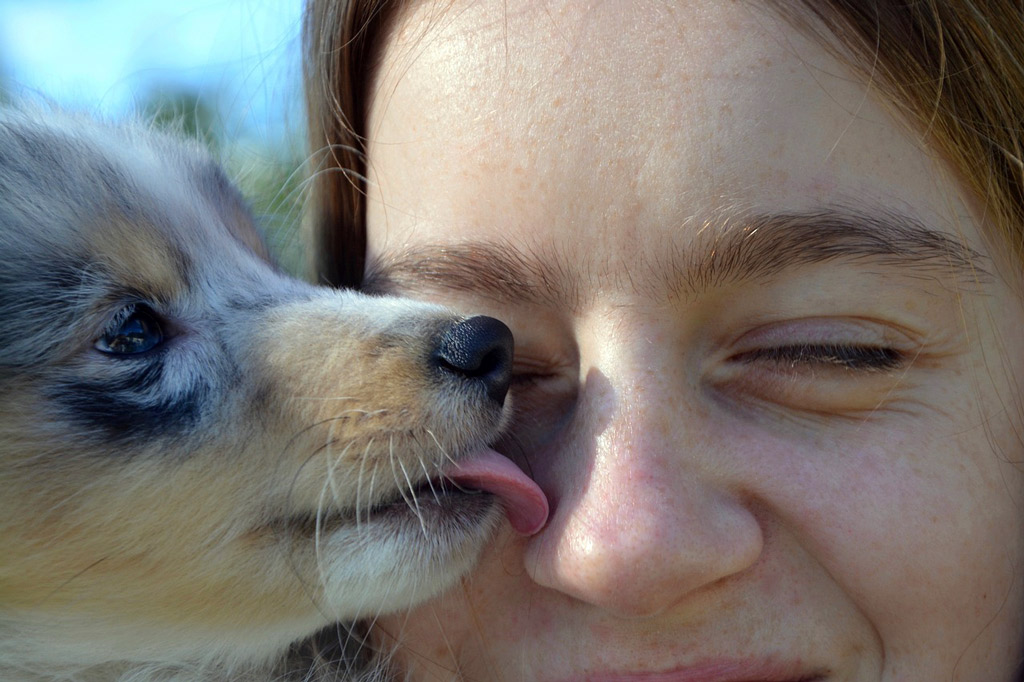
It’s easy for us to show affection to our dogs, but what about the reverse? You might wonder how your dog says “I love you”.
How does your dog show you that he cares?
First, understanding your dog’s body language for affection is easy, just pay attention to the following behaviours (watch those love signs life in this video):
Thankfully, dogs do communicate clearly, as long as you know what to look for. From nose to tail, dogs use their whole bodies to convey how they feel.
10 Ways Your Dog Tells You “I Love You”
Here’s how dogs express affection:
#1 – Nosing
Does your doggy ever come to you and nudge you with his nose? This can be a sign of affection. Of course, nose-nudging is also a way for your cheeky doggy to seek attention.
You will know your dog is expressing affection if the nose-nudge is accompanied by a soulful stare, or leads to more full-body contact.
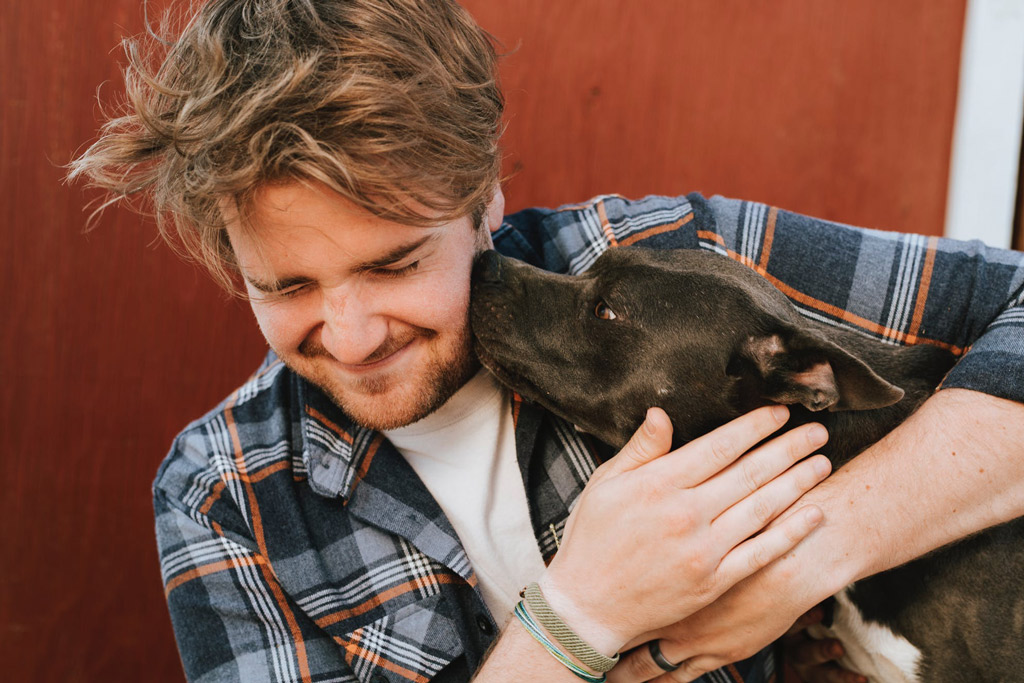
#2 – Eye Contact
Eye contact is an intimate act. For many dogs, it’s a display of:
- Trust
- Attachment
- And affection.
You’ll see your dog has a soft expression, maybe with slightly squinty eyes.
This gaze should be a voluntary behaviour, i.e. you shouldn’t hold a dog’s head still and stare into his eyes hoping for a mutual loving gaze.
This can be a common mistake made by young children who often like to hold dogs still so they can look at them more closely. Your dog could take this action as a threat and may not react affectionately at all.
Affectionate eye contact is different from threatening eye contact. Most people are uncomfortable being stared at by other people, so it’s easy to imagine how unsettling it might be for your dog. Plus, direct prolonged eye contact with dogs is very confrontational (in canine body language, it suggests confrontation).
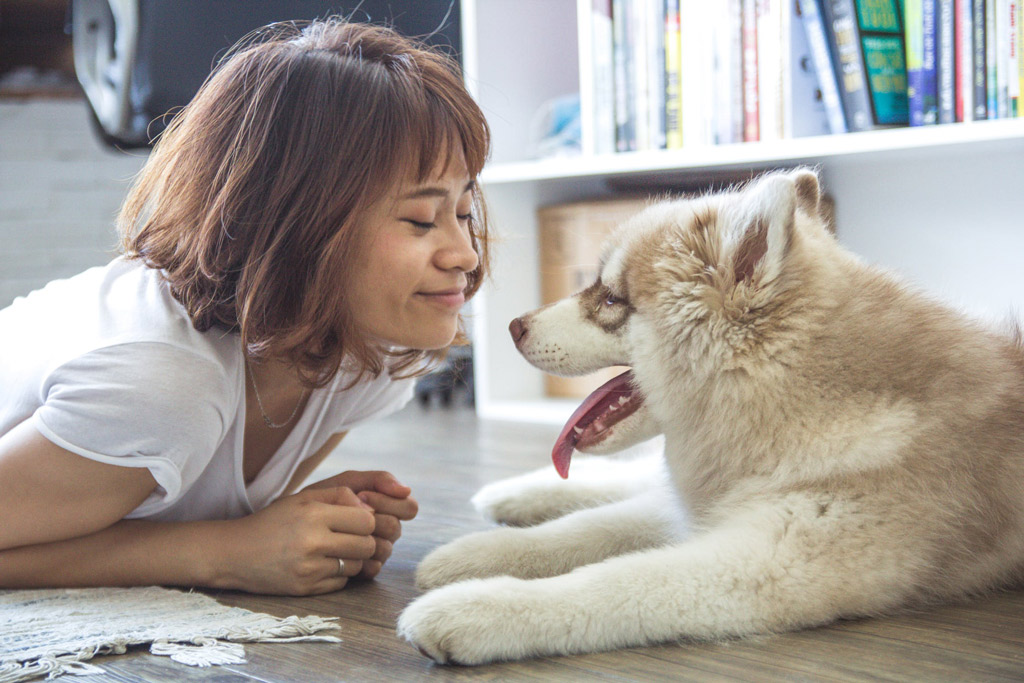
#3 – Sighing
Does your dog ever stretch out next to you and let out a long sigh? Soft vocalizations like sighs and low groans are signs of contentment in dogs.
If your dog snuggles up and sighs, it means they feel safe and comfortable by your side.
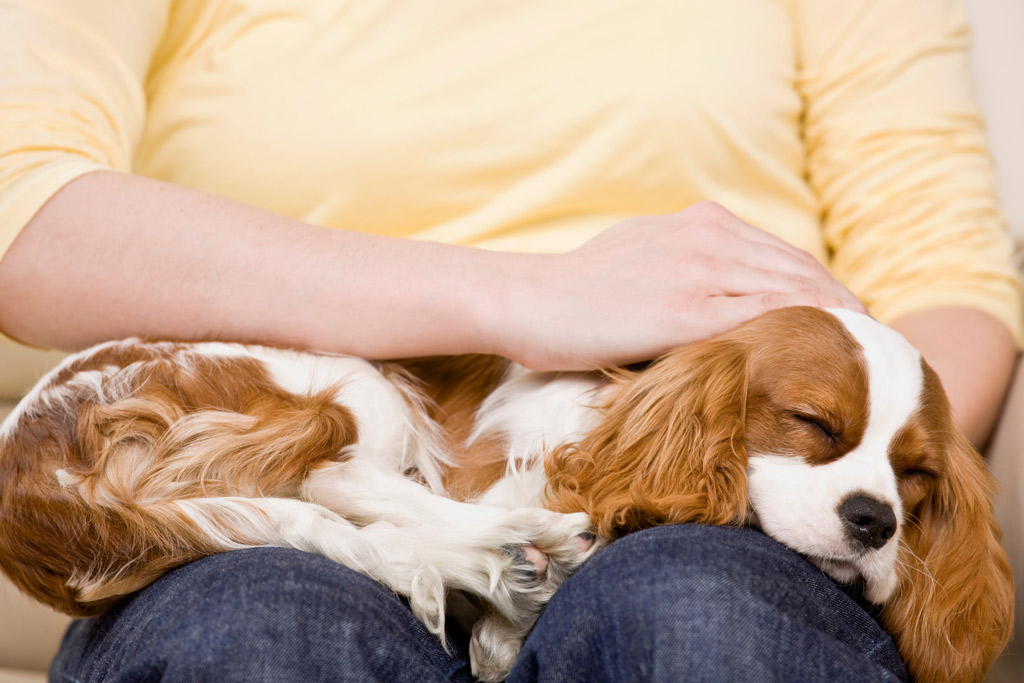
#4 – Licking
Kissing is a universal sign of affection, even among dogs! Some people love puppy kisses, while others don’t. But by licking you, your dog is saying: “I like you very much!”
In addition, licking can also be a way to signal a lower social status. When your dog licks you, he may be letting you know that he respects your authority too.
But, are dog kisses safe? Unfortunately, we don’t really know what’s in our dog’s saliva or if it presents a possible health risk.
To begin with, there are lots of bacteria foreign to the human body in dog saliva. Usually, our skin provides an effective barrier against potential pathogens in their saliva.
“One of the main reasons we can get infections from our pets is that our bacterial ecosystems are so different from each other.”
Floyd Dewhirst, a bacterial geneticist at the Forsyth Institute and professor of oral medicine at Harvard.
Although throughout history it has been suggested that canine saliva can heal rather than harm, your pet’s tongue is not a magic source of germ-killers.
“The main thing pet owners need to watch out for is any chance for those bacteria to get through the skin. Once they get inside us, bacteria find a moist, happy environment in which to grow, potentially leading to infection.”
Kathryn Primm, veterinarian.
So, if there’s a break of any kind in your skin don’t let your dog lick the area. If that happens, it’s best to seek a doctor to be safe.
In conclusion, dog kisses are usually not harmful as long as your immune system is strong and you don’t have any wounds on your face or mouth that would let bacteria into your bloodstream. Moreover, Primm advises keeping in mind that babies and the elderly can have weaker immune systems than healthy adults.
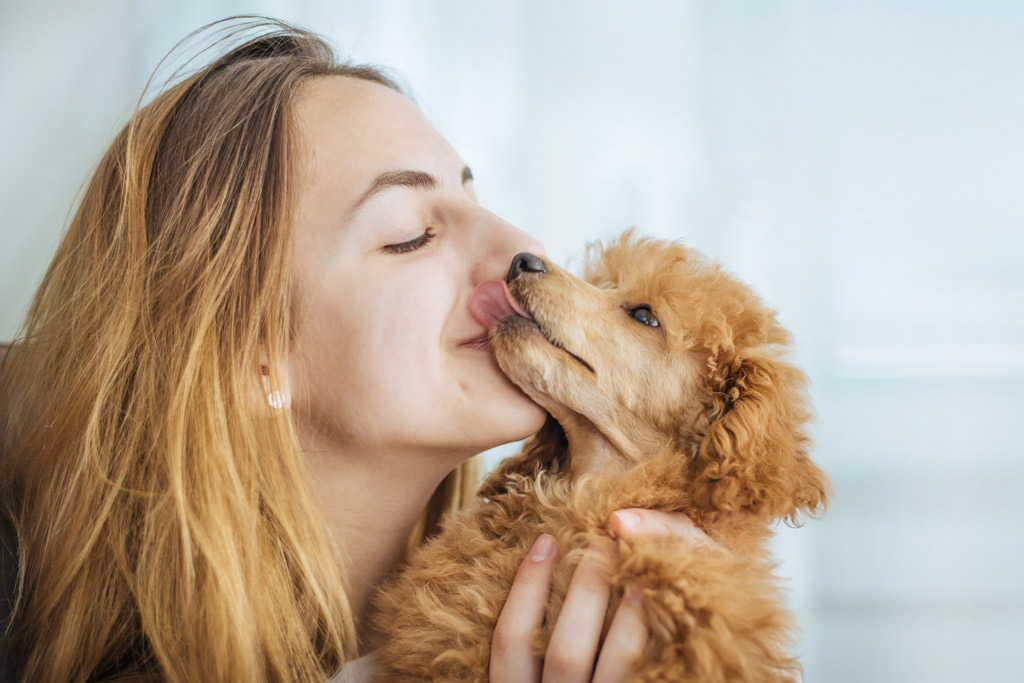
#5 – Jumping
Now, here’s a sign of affection you may not want to encourage.
For many people, jumping is an undesirable dog habit. But it may help to reframe it as a loving act of enthusiasm. If your dog gets extra-bouncy around you, they’re showing you how much they care.
For instance, dogs are drawn to human faces, and jumping can be a way to get closer!
Think of it this way… When your furry friend jumps, he can get a closer look at your eyes, or reach you for a welcoming lick.
Jumping can be a frustrating habit, but the next time your dog jumps up, remember that they may just be trying to show you they care.
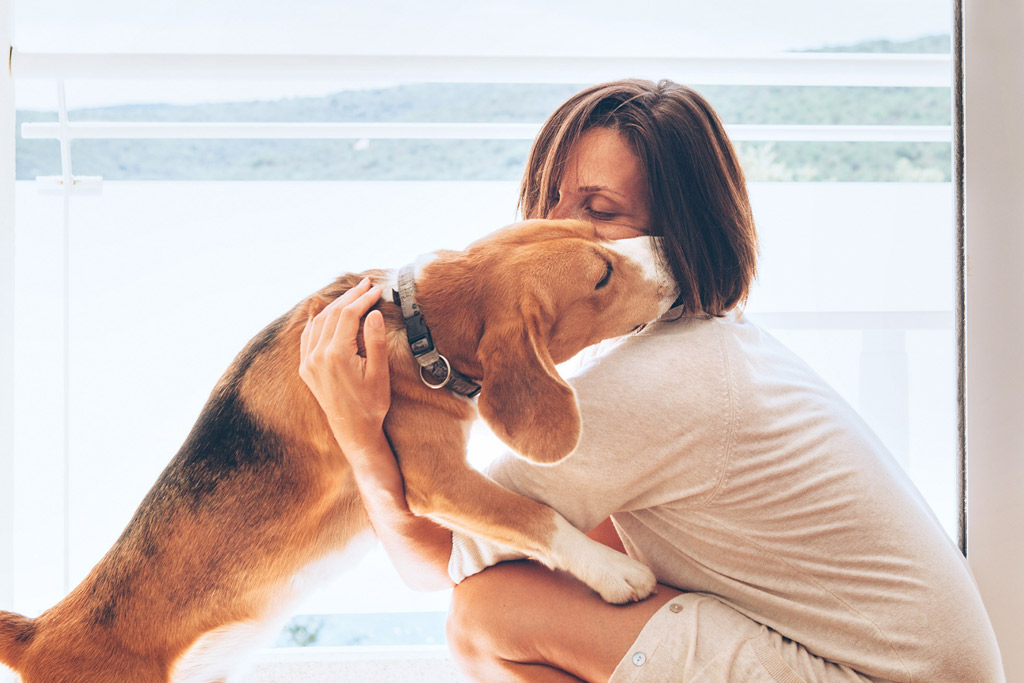
#6 – Leaning
When your doggy comes up to you and leans with their full weight against your legs, they’re showing you that they implicitly trust you.
For many dogs, the lean is like a full-body hug. Of course, some leans also signify anxiety or control. The affectionate lean is relaxed and calm.
Your dog may show other signs of relaxation, like:
- A slightly open mouth.
- Soft eyes.
- A gently wagging tail.
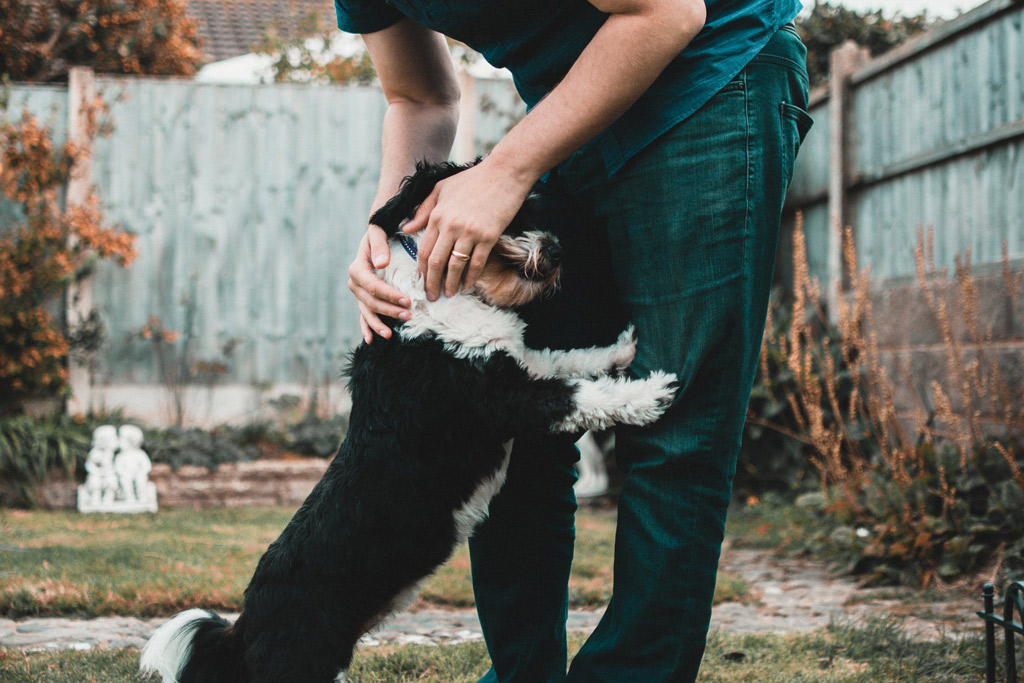
#7 – Rolling
Nothing says “I like you” like a dog rolling onto their back and asking for belly rubs.
Similar to a lean, the roll-over shows a high degree of trust and relaxation.
When your pooch flops over and wags their tail, he is telling you that he likes you and trusts you A LOT.
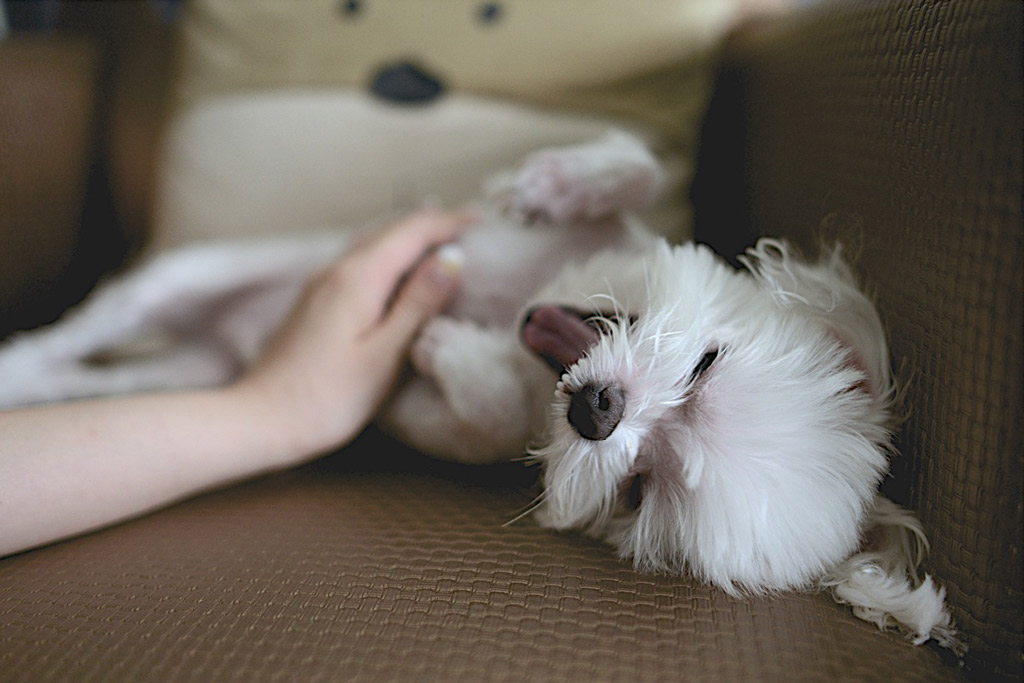
#8 – Greeting You
This doesn’t necessarily mean an all-out bonkers greeting.
In fact, a super-crazy over-the-top greeting can be a sign of separation anxiety, not an indicator of affection.
Your dog approaching you with a wagging tail is enough to indicate your dog is happy to see you.
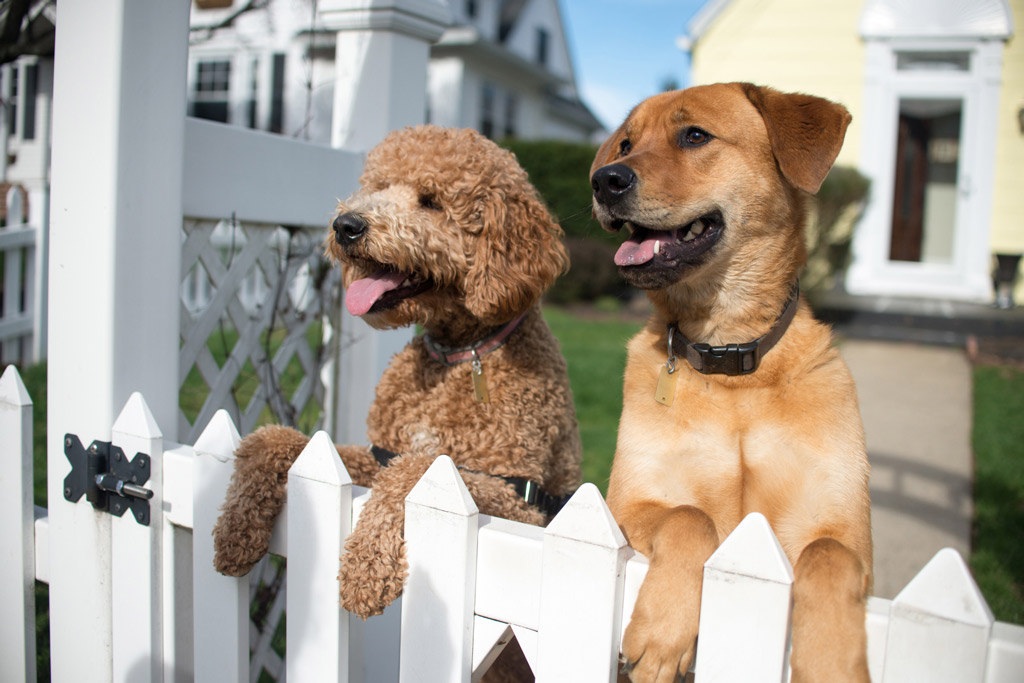
#9 – Cuddling
Does your dog love to cuddle up next to you? If you have a dog that cuddles, consider yourself lucky since not all dogs love to cuddle. Some dogs like their own space and sleep in their own bed. Others, however, are super cuddly and can’t get close enough to you!
This is a pure and simple sign of affection and a great way to bond with each other.
So why do some dogs love to cuddle? Cuteness aside, think of it from an evolutionary standpoint. When puppies are born, they snuggle with one another to keep warm.
When humans started domesticating dogs, they were there to protect their owners but they were also there to help keep their owners from freezing to death. For thousands of years, humans and dogs have been cuddling up for warmth! So, sometimes your pooch is snuggling under the blankets with you simply because they are cold.
Furthermore, cuddling is a great stress reliever for dogs as well. It has been proven that petting and snuggling your best friend can increase oxytocin levels in both of you. Oxytocin is the “love hormone” and is associated with social bonding and also trust.
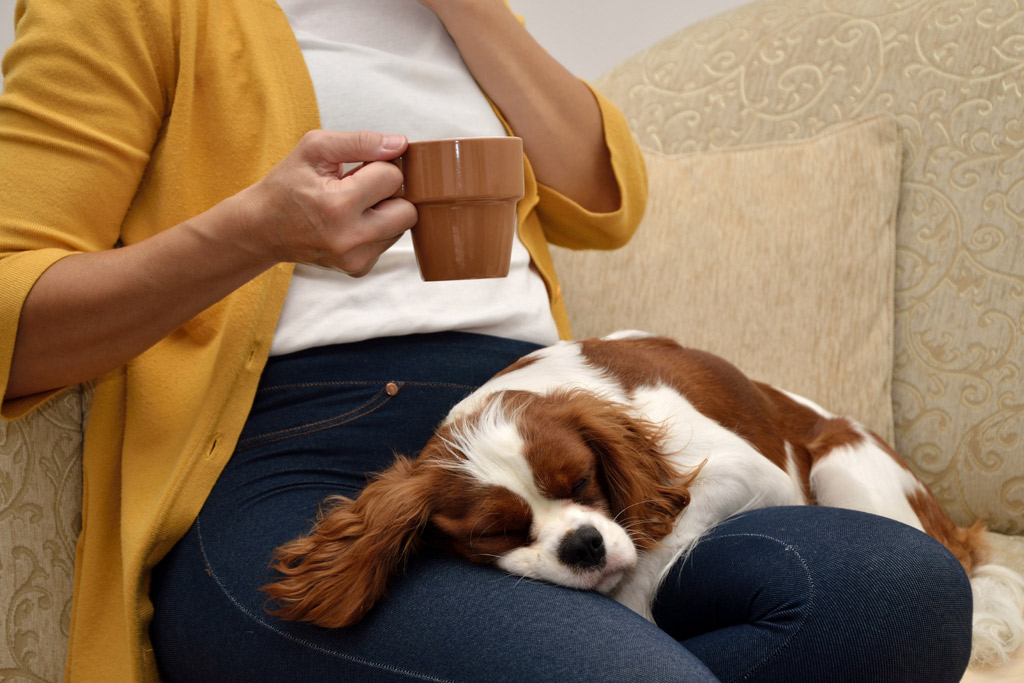
#10 – Tail Wagging
Lots of people think a tail wag is always a friendly gesture, but it can have lots of different meanings— some not so nice.
But when your dog gives a full-body wag with the tail held at mid-height, the message is clear.
They’re happy and excited to see you, the person they love and trust.
Finally, research showed that if your dog’s tail wags more to the right side of his rear when he sees you, it’s a signal that he feels good about your presence.
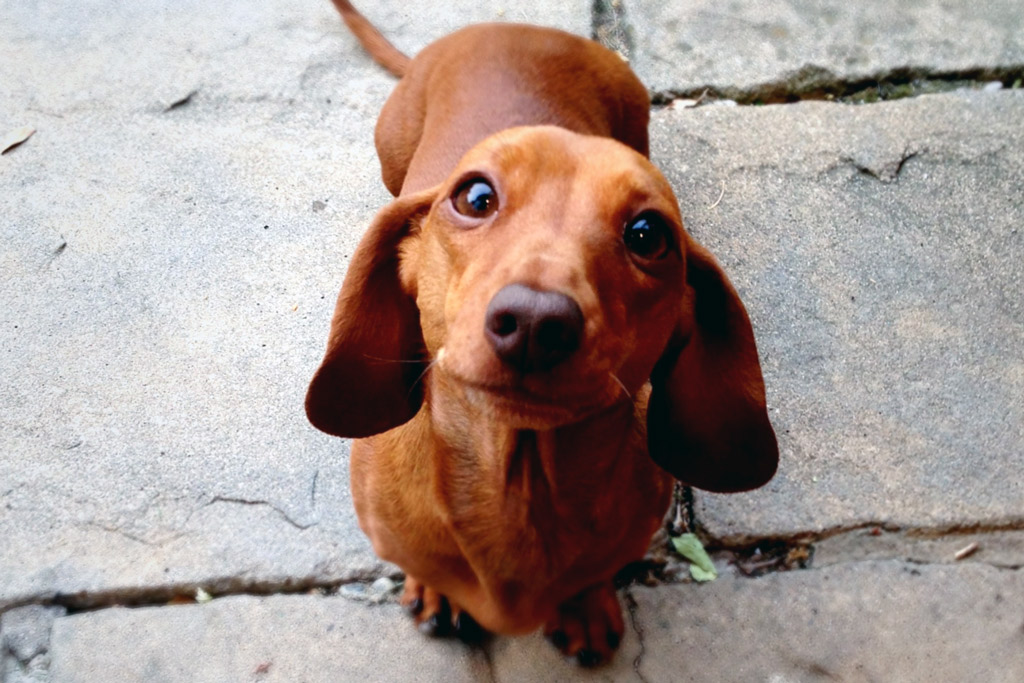
Why Some Dogs Are More Affectionate than Others
Some dogs like to cuddle more than others and show more affection to their owners. And it seems that genetics has something to do with it.
Certain breeds are believed to be more cuddly, while others tend to be less affectionate and more independent.
However, there’s a difference between your dog snuggling next to you and you hugging your dog. Note that canines really don’t get these human expressions of affection and can be confused by them.
In other words, dogs, in general, do not like to be hugged and kissed, especially by strangers. Also, since dogs are typically being held (restrained) during the bear hug, it increases their stress level.
So, unless your dog is remaining contentedly still on his own while being hugged or kissed, it’s best to stick to stroking and petting, which most dogs can’t get enough of.
What dog Breeds Are More Cuddly?
You can rely on lapdogs to be more snuggly. Certain breeds have been bred small enough to sit on our laps. Such as the:
- Maltese.
- Pomeranian.
- Yorkshire Terrier.
There are bigger breeds that are cuddle bugs as well, like the:
- Golden Retriever.
- Irish Wolfhound.
But sometimes it is just about the individual dog and it has nothing to do with genetics. Each dog expresses himself in different ways. Some like to be affectionate, and some like to keep their distance.
There are also dogs that are referred to as velcro dogs. They are clingy and they like to follow their owner everywhere they go. This doesn’t mean that they are also going to love to cuddle, but they definitely like being around you.
If you want to know more about velcro dogs, check our Why Does My Dog Follow Me Everywhere I Go? blog post.

6 Ways to Show Your Dog Affection
Letting your dog know that you love him each and every day can be easy with simple acts and gestures.
#1 – Create Cuddle Time
This could be a snuggle session on the couch after work or a belly rub in the morning.
Also, a gentle massage is a great idea since dogs don’t really understand pats on the head, hugs or kisses.
#2 – Leave Toys When You Go Out
To make it easier for your dog, leave something behind to keep him entertained, like a toy. Also, you can use a stuffed toy with treats inside to keep him busy.
Some dog owners also like giving their pooch a piece of old clothing that retains their smell, to comfort their dog when he’s alone at home.
#3 – Hang Out with Your Dog
Taking your furry friend along for errands or a trip. He will definitely prefer to be around you most of the time, so take advantage of this and bring him along if and when you can.
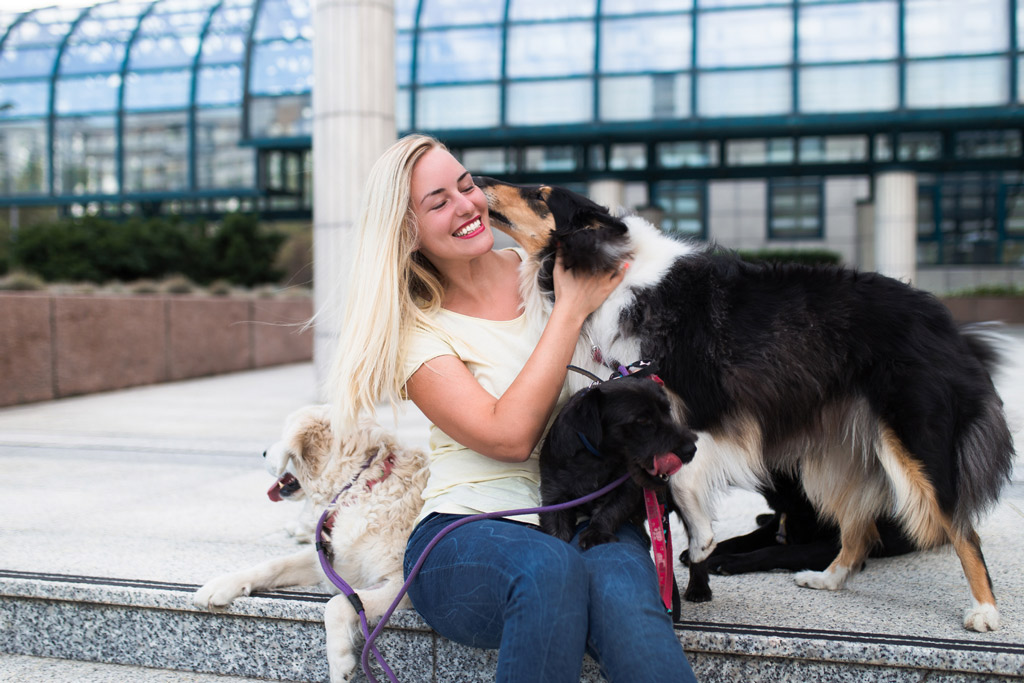
#4 – Take Walks Together
It’s not just because of the exercise – which is fundamental for his health and has benefits for yours – it’s also so you spend time together.
You can take a walk around your neighbourhood, go to the park, or the beach. It doesn’t really matter to your dog as he will love this opportunity to explore the world with you!
#5 – Praise His Good Behaviour
It’s very important to reward your dog’s positive attitude every time to encourage him to repeat good behaviour.
You can praise him with some affection or a healthy treat. This will encourage him to follow your command since you are his main source of food and fun.
#6 – Add Training and Playtime to the Schedule
No matter your dog’s age, keep his mind engaged as part of his daily routine. Dogs need physical and mental activities to stay healthy.
To start, you can dedicate 15minutes a day to teach him a command or a new trick.
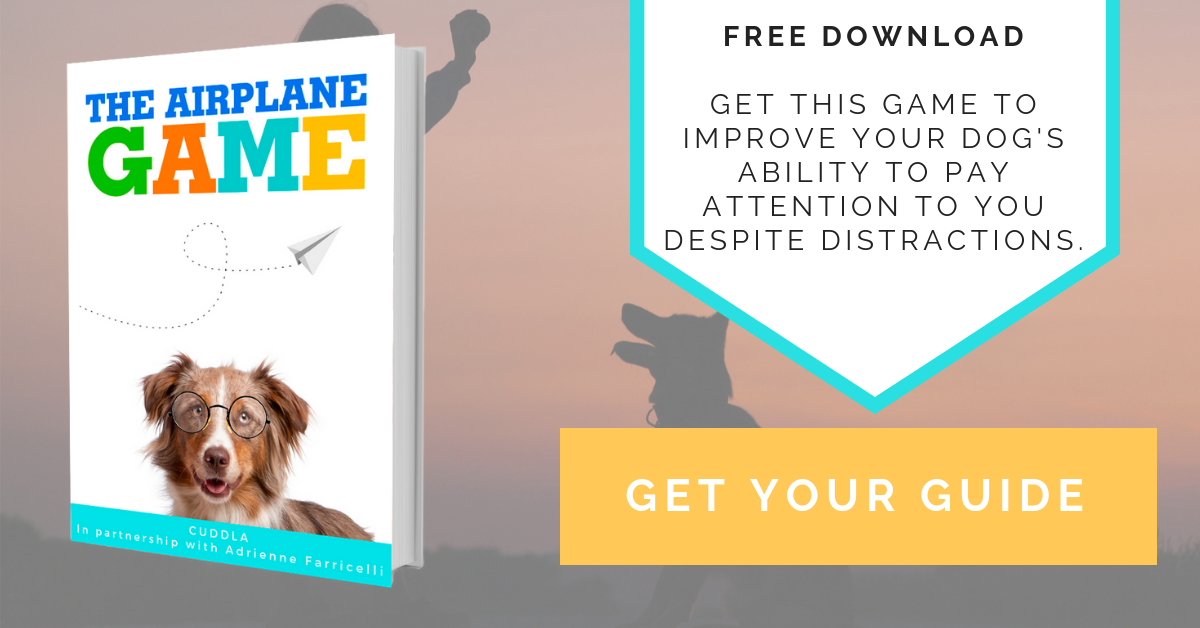
Brain games are fun games that you can play with your dog to teach him new skills and increase his intelligence. If you want to teach your dog new tricks in a fun and highly rewarding way, check out my favourite training method.
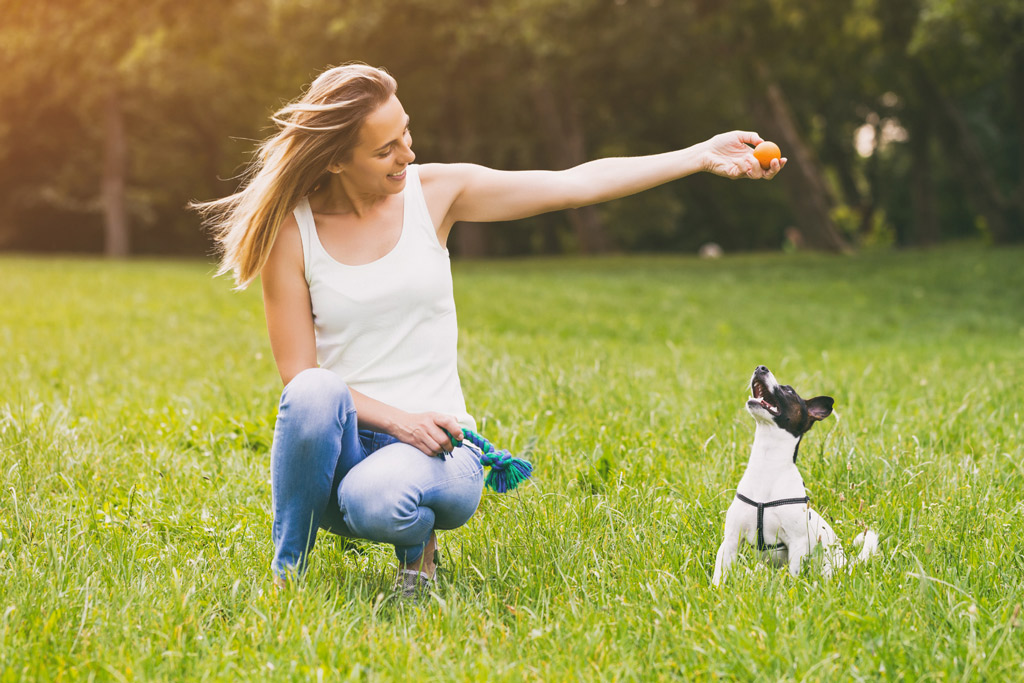
How to Have a Healthy and Safe Interaction with Your Dog
Dr Becker, an integrative veterinarian, recommends following these simple tips for a healthy interaction with your furry friends:
#1 – Refuse Unnecessary Antibiotic Treatment
Unnecessary use of these drugs causes antibiotic resistance in a growing number of bacteria strains. When antibiotics are no longer effective against serious bacterial infections, the results and consequences can be lead to life-threatening.
#2 – Consider Giving Your Dog Probiotic
A high-quality probiotic supplement will improve your pet’s digestive tract with healthy bacteria, boost his immune system and improve overall health. This is especially important if your dog has received antibiotic therapy.
#3 – Cover Open Cuts, Sores and Skin Abrasions on Your Skin
The real danger of pet saliva is with people who allow their dog to lick an area of skin that is wounded and could potentially allow bacteria into the bloodstream.
So if you have any sort of injury to your skin, no matter how minor, either keep it covered around your pet or don’t allow him to lick you until the wound is fully healed.
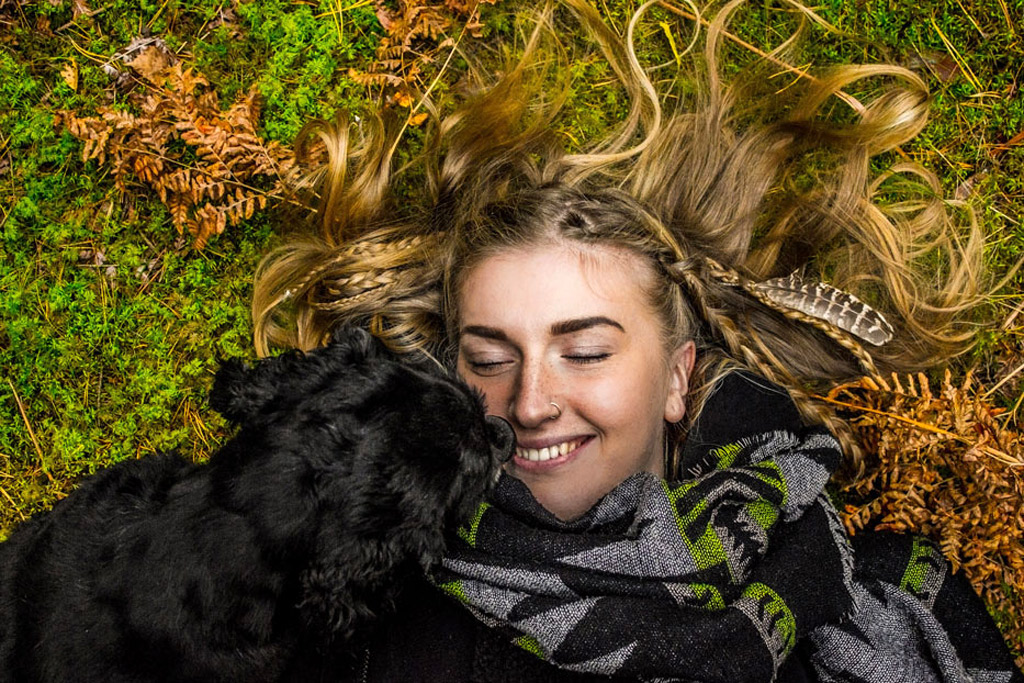
#4 – Practice Good Hygiene
The very best way to ensure you and your pet don’t swap germs is to wash your hands before and after you handle your dog, and before touching food.
In addition, if your pet gives you kisses, wash your face (or wherever she licked you) after each smooch session.
Brush and bathe your dog when necessary, so you can cut down on the dirt, allergens and bacteria he brings into the house on his body and especially, his feet.
#5 – Treat Bites Seriously
Immediate treatment is necessary, whether the bite is superficial or more serious. Clean the wound immediately with soap and warm water, rinsing thoroughly.
For superficial wounds, disinfect several times a day with diluted povidone-iodine and cover the wound with a clean, dry dressing. Watch for signs of infection, including redness and swelling.
Finally, if the bite is a deep puncture wound, seek medical attention immediately, as more intensive treatment may be required.
P.S. If you want to know more about dog care, check out our The 5 pillars to a happy and healthy dog blog post.
